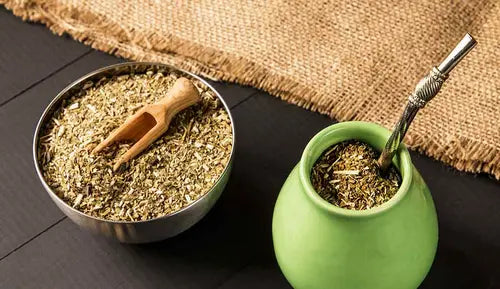
Maté Yerba, health infusion
Time to read 4 min
Time to read 4 min
Table of contents
The Yerba Mate (pronounced yair-bah mah-tay) is a tree native to South America.
Its infusion, similar to tea, stands out for its nutritional profile, taste, and the ceremonial way it’s enjoyed.
It’s also the most consumed beverage in South America—a traditional drink shared for centuries and infused with Latin culture.
Yerba mate has its roots in the Indigenous cultures of South America. The Guaraní tribes—living in what is now Paraguay, Argentina, and Brazil—were among the first to cultivate and drink mate. They used the leaves of the mate tree to prepare an infusion rich in caffeine, antioxidants, and essential nutrients.
European colonists arriving in South America in the 16th century quickly adopted the drink, consuming it in special gourds and using a metal straw called a “bombilla” to sip the liquid. Since then, yerba mate has become a tradition deeply rooted in South American culture.
Yerba mate is consumed by millions every day for its powerful ability to naturally boost focus, mental clarity, and physical endurance.
Originating from northern Argentina, Paraguay, and southern Brazil, yerba mate has its own culture rooted in the values of friendship and sharing.
It’s often said that yerba mate offers the benefits of tea and coffee without the drawbacks of caffeine effects sometimes associated with those popular drinks (palpitations, stomach aches, trouble falling asleep…).
There are three main benefits to drinking yerba mate:
| Rich in nutrients & antioxidants | Supports mental clarity | Optimises GLP-1 |
But the product is far more complex—and even more beneficial to health. Summarising it in three points would undersell this remarkable plant.
Above all, it’s a natural stimulant. Yerba mate contains caffeine, but its effect is gentler than coffee. It provides an energy lift without the jitters and crashes often linked to caffeine.
It’s rich in antioxidants. While fruits and vegetables are the primary source—hence “5 a day”—yerba mate, like green tea, is also a source of antioxidants such as polyphenols that help protect cells from free-radical damage.
It enhances mental clarity and focus. Theobromine, a bitter compound found in cocoa, is a mild stimulant that offers longer-lasting effects than caffeine with fewer side effects. Unlike caffeine (which acts on the central nervous system), theobromine primarily affects smooth muscle as a natural relaxant. Yerba mate is known to improve clarity, support focus, and benefit cognitive function—great for studying or work.
It optimises GLP-1. Research suggests yerba mate may increase GLP-1 production, potentially promoting insulin secretion and satiety. This could help maintain blood sugar control and regulate appetite; potential GLP-1 stimulation may also support digestive and metabolic function.
It supports digestion. Yerba mate has been linked to better digestion and may help relieve certain gastrointestinal issues. It stimulates gastric acid secretion and bile production thanks to saponins, a plant component that can help eliminate intestinal parasites—thus yerba mate naturally supports digestion. It also has diuretic properties that support gut health, helps keep the colon clean, and facilitates waste elimination. It may also aid digestion of rich, fatty foods. All of this makes digestion easier!
It’s ideal for physical activity. Consuming yerba mate (and caffeine generally) before exercise may improve endurance and performance. During effort, theobromine can favour bronchodilation, increasing airflow to the lungs. And as noted, its antioxidants may help reduce muscle soreness and burning sensations post-workout. It’s a great choice before, during, and after activity!
Yerba mate holds a special place in South American culture. It’s often shared among friends and family, creating a sense of community. Argentinians and Uruguayans, in particular, are known to drink mate throughout the day. This tradition strengthens social bonds and encourages relaxation.
As mentioned, yerba mate is a sharing drink traditionally enjoyed in a gourd with a bombilla (filtered straw), in a convivial, ceremonial way:
The Cebador is the “master of ceremony.” They prepare the beverage and then share it with the person to their right.
The Matero is the person who receives the infusion. They enjoy the yerba mate and the shared moment.
When the Matero no longer wishes to drink, they should say “Gracias” to the Cebador when the gourd is offered; the Cebador will then stop offering it.
We also offer accessories to enjoy your yerba mate the traditional way!
And because we love making life easier, here are a few videos from Matéina to help you brew yerba mate just the way you like it!
What is yerba mate?
Yerba mate is an infusion made from the leaves of the Ilex paraguariensis tree, native to South America. Enjoyed hot or cold (tereré), it’s a beverage rich in caffeine, theobromine, and polyphenols.
What are its health benefits?
Yerba mate is known for stimulating effects, antioxidant richness, and benefits for digestion, focus, physical performance, and metabolism. It’s often compared to coffee and tea for its steady energy without typical side effects.
What’s the difference between hot mate, tereré, and mate cocido?
Hot mate: traditional infusion, sipped from a gourd with a bombilla.
Tereré: cold version, very popular in Paraguay, often flavoured with herbs or juice.
Mate cocido: bagged mate, milder, brewed like filtered tea.
What is the cultural origin of mate?
Consumed since pre-colonial times by the Guaraní and Tupí, yerba mate was domesticated by Jesuits in the 17th century and became a major export in South America. Its social sharing tradition is still very much alive today.
Are there any precautions when consuming it?
Yes. Very hot beverages (above 65 °C / 149 °F) are classified as “probably carcinogenic” by the IARC. Also, smoke used to dry some leaves can contain polycyclic aromatic hydrocarbons (PAHs), which may be harmful. Prefer warm infusions or non-smoked varieties.
Your cart is currently empty.
Start Shopping











